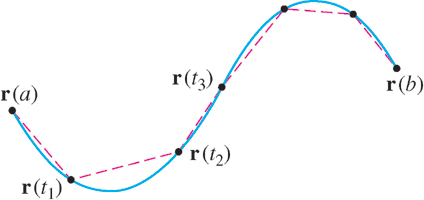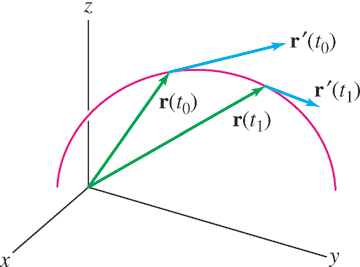13.8 13.3: Arc Length and Speed
In Section 11.2, we derived a formula for the arc length of a plane curve given in parametric form. This discussion applies to paths in three-
REMINDER
The length of a path or curve is referred to as the arc length.
Recall that arc length is defined as the limit of the lengths of polygonal approximations.

we choose a partition a = t0 < t1 < t2 <⋯< tN = b and join the terminal points of the vectors r(tj) by segments, as in Figure 1. As in Section 11.2, we find that if r′(t) exists and is continuous on [a, b], then the lengths of the polygonal approximations approach a limit L as the maximum of the widths |tj − tj−1| tends to zero. This limit is the length s of the path which is computed by the integral in the next theorem.

THEOREM 1: Length of a Path
Assume that r(t) is differentiable and that r′(t) is continuous on [a, b]. Then the length s of the path r(t) for a ≤ t ≤ b is equal to

Keep in mind that the length s in Eq. (1) is the distance traveled by a particle following the path r(t). The path length s is not equal to the length of the underlying curve unless r(t) traverses the curve only once without reversing direction.
EXAMPLE 1
Find the arc length s of r(t) = 〈cos 3t, sin 3t, 3t〉 for 0 ≤ t ≤ 2π.
Solution The derivative is r′(t) = 〈−3 sin 3t, 3 cos 3t, 3〉, and
∥r′(t)∥2 = 9 sin2 3t + 9 cos2 3t + 9 = 9(sin2 3t + cos2 3t) + 9 = 18
Therefore,  .
.
Speed, by definition, is the rate of change of distance traveled with respect to time t. To calculate the speed, we define the arc length function:

Thus s(t) is the distance traveled during the time interval [a, t]. By the Fundamental Theorem of Calculus,

742
Now we can see why r′(t) is known as the velocity vector (and also as the tangent vector). It points in the direction of motion, and its magnitude is the speed (Figure 2). We often denote the velocity vector by v(t) and the speed by υ(t):


EXAMPLE 2
Find the speed at time t = 2 s of a particle whose position vector is
r(t) = t3i − etj + 4tk
Solution The velocity vector is v(t) = r′(t) = 3t2i − etj + 4k, and at t = 2,
v(2) = 12i − e2j + 4k
The particle’s speed is  .
.